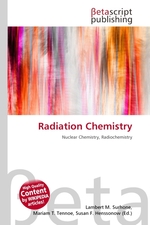Radiation Chemistry
Lambert M. Surhone, Mariam T. Tennoe, Susan F. Henssonow
бумажная книга
High Quality Content by WIKIPEDIA articles! Radiation chemistry is a subdivision of nuclear chemistry which is the study of the chemical effects of radiation on matter; this is very different from radiochemistry as no radioactivity needs to be present in the material which is being chemically changed by the radiation. An example is the conversion of water into hydrogen gas and hydrogen peroxide. A recent area of work has been the destruction of toxic organic compounds by irradiation; after irradiation, "dioxins" (polychlorodibenzo-p-dioxins) are dechloroinated in the same way as PCBs can be converted to biphenyl an inorganic chloride. This is because the solvated electrons react with the organic compound to form a radical anion, which decomposes by the loss of a chloride anion. If a deoxygenated mixture of PCBs in isopropanol or mineral oil is irradiated with gamma rays, then the PCBs will be dechlorinated to form inorganic chloride and biphenyl. The reaction works best in isopropanol if potassium hydroxide (caustic potash) is added.
Данное издание не является оригинальным. Книга печатается по технологии принт-он-деманд после получения заказа.


